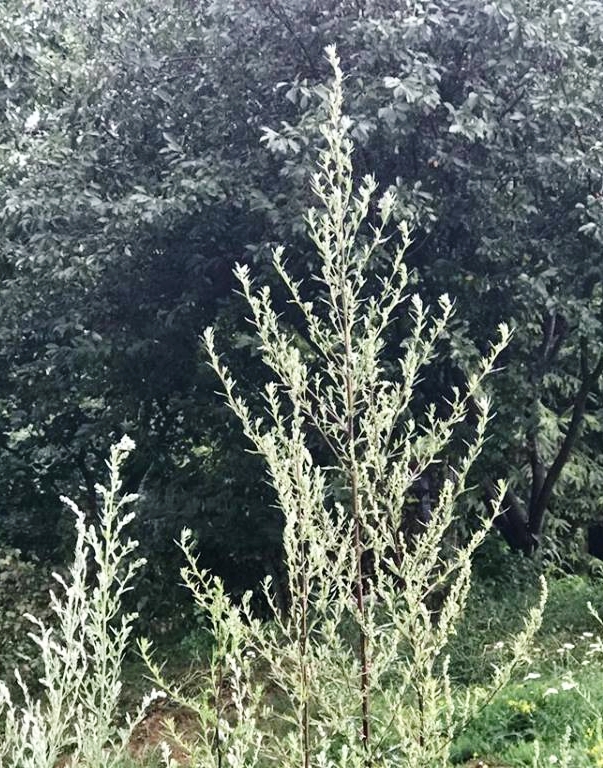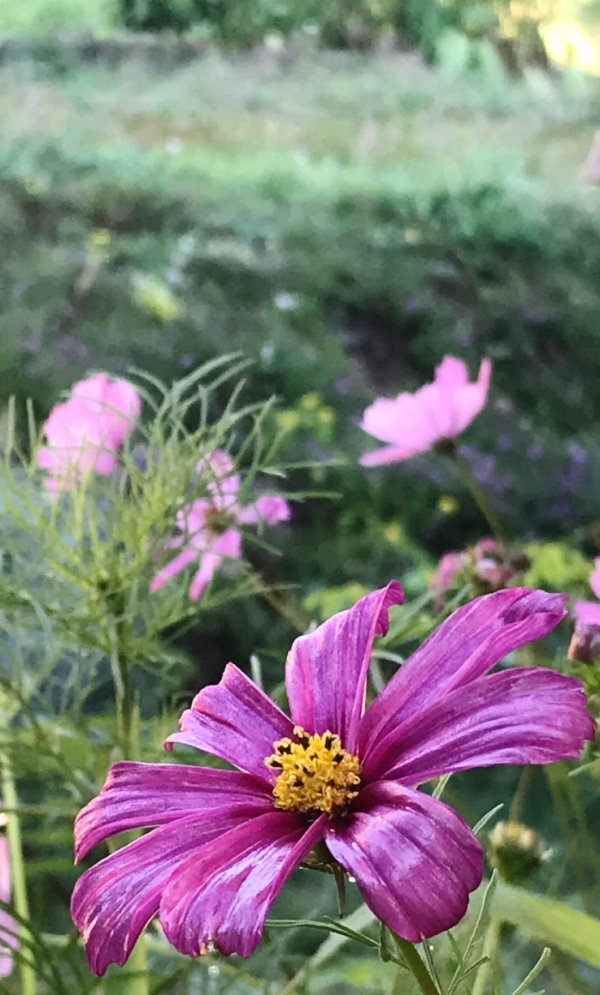Mugwort: Home Medicine Cycle
/Plant identification can be tricky and it is the biggest safety concern for the herbalist. While it is possible to hurt yourself with too much of a known herb or by using an herb improperly, it is much more likely that harm from herbs will result from incorrect identification.
For me, there's the particular issue that I'm more than 90 percent blind. I've always had trouble gathering herbs in the wild because everything in a meadow just looks generic green unless I put a leaf up two inches from my eye.
That's why most of my work with herbs focuses on things I can grow. My herb gathering is a lot more efficient that way. And when I plant and nurture an herb through the seasons, I am sure what I'm getting and I learn it's smell, texture and taste long before I have to go off and identify it in the wild
My mugwort plant top
But even growing your own isn't always a sure thing. Some years ago, I planted what were supposed to be mugwort seeds and a plant sprouted. The leaves looked a bit thinner and wispier than the online photos of mugwort. The flowers were also greenish brown, rather than the dusky red shown in must mugwort pictures in books and online, so I asked some of the women from the local village who had a little knowledge of herbs. Two of them insisted that it wasn't mugwort but possibly something related.
Mugwort (Artemisia vulgaris) is related to wormwood (Artemisia absinthium) but this didn't appear to be that either. I had read that mugwort is occasionally mistaken for poisonous hemlock, which can be deadly, so I was more than a little cautious.
For several years, I let the plant live in the corner of my herb garden and each year it got bigger, beating out other hardy plants. Finally, I decided I had to fully research the identification for once and for all or get rid of the plant. The main markers for differentiating between mugwort and hemlock are the smell, the silvery sheen and small hairs on mugwort leaves, and later in the year, the flowers.
Smell would someday be key for me but first I had to know the plant intimately to identify the smell. It was too early in the year for flowers (and mugwort is usually harvested before it blooms, so this is a common problem in mugwort identification) and relying solely on the hairs and a silver sheen of the leaves seems a bit shaky when your life is literally at stake.
My mugwort stem
First, I carefully picked each individual part of the plant--the leaves, buds and stems--photographed them and put them through a plant analysis program. That program quickly proclaimed it to be mugwort. But I wasn't convinced. There were still the village women, who weren't exactly experts but they were local people with some experience in the natural environment.. So, I sent my samples in to a plant identification group. Finally, I got back my answer.
It is mugwort. Several members of the group explained more clearly the most crucial identifying characteristics. The stem of my plant is clearly ridged and purple all over. Hemlock has a stem that is barely ridged at all and only spattered with purple (like when someone does an ink spattering art project). The flowers are quite different and I could confirm from previous years that while my flowers are a bit pale, they do match some photos of mugwort and most certainly are not hemlock flowers.
It was a relief to finally make the determination and not have to uproot my plant. But I don't regret any of the time and caution spent to confirm it. Even with a plant I grew myself, the risk of dealing with a poisonous plant is there and always worth considering.
My mugwort buds
As soon as I was sure of it, I used some mugwort leaves to settle a sour stomach I had been struggling with for several days and made a bath of it for my kids who had bug bites all over their arms and legs from summer camp in the woods. My son also had a weird rash that might be bug bites, an allergic reaction of some kind or possibly skin parasites. Mugwort soothes bug bites and some other allergies but more importantly it is one of the best remedies for skin (and stomach) parasites.
I doubt the rash was parasites in this instance. But again, it's better to be safe than sorry. Now at least I have mugwort on my side for that.
Mugwort leaves and buds are used in teas, tinctures, washes and salves for a variety of discomforts and diseases, particularly stomach acidity, ulcers, constipation and intestinal parasites as well as skin infections. Mugwort is strongly antibiotic and anti-microbial. The tea has a calming effect on nerves and can help regulate abnormal hormone levels, which could be helpful for insomnia and obesity.
Women with light or sporadic periods can use mugwort to regulate menstrual flow and reduce the related pain of menstruation. Yarrow and/or red raspberry leaf may be better herbs for those with heavy menstruation, but mugwort has also been shown to bring relief during menopause.
My mugwort leaf
Still, while mugwort isn't poisonous, it does have a low level of toxicity that could cause temporary sickness if more than three cups of the tea are taken per day for several days in a row. It is best used as a short-term treatment for digestive problems, even though thousands of people drank it daily during WWII when tea was difficult to obtain in Britain and people drank mugwort tea instead.
The most important warning on mugwort is that it has been used to bring about abortions and to stimulate the uterus while giving birth. Given that, it isn't at all appropriate for pregnant women, and due to the low level of toxicity, shouldn't be ingested by nursing mothers either.
A less worrying application of mugwort is for the skin. Just as it rids the body of intestinal parasites it can fight skin parasites that few modern medications are effective against. It also alleviates itching and reduces the inflammation of bug bites. It is a particularly effective bug repellent, so salves and oils infused with mugwort leaves or a few drops of mugwort essential oil can keep the bugs off of you in the first place.
Compounds contained in mugwort have been found to combat cancer in a Chinese study and other studies point to possible uses for joint pain associated with arthritis. But these uses will require further research to be fully realized.
What is clearly scientifically demonstrated is the antibiotic and antimicrobial properties of mugwort. As well as preventing infections as a skin wash, the dried plant can be used as a smudge to kill airborne bacteria and prevent the spread of disease both at home and in places of business where incense is burned, such as massage parlors, where the pleasant smell of a mugwort smudge will blend right in.
Both mugwort tea and mugwort smoke have a history, dating back to Aztec religious ceremonies, of being used for lucid dreaming and astral travel. Compounds in mugwort are psychoactive but the effect is not one of dramatic hallucinations. There are many reports of predictive dreaming connected to mugwort and experiments with dreams might benefit from its use.
As with all posts on medicinal herbs, this is not intended as specific medical advice for any particular person. Allergies to mugwort do exist and those with serious symptoms of disease should seek medical attention.

























